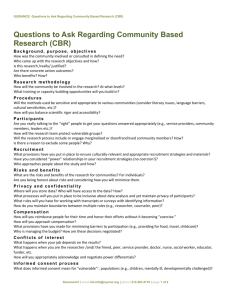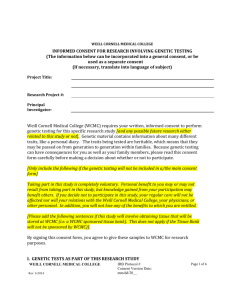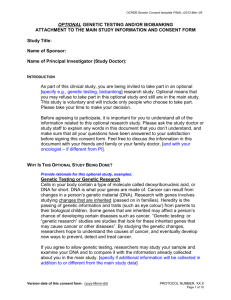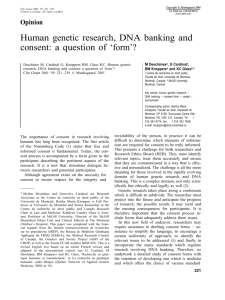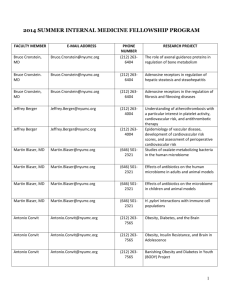Protocol Development for Genetic Research Studies
advertisement
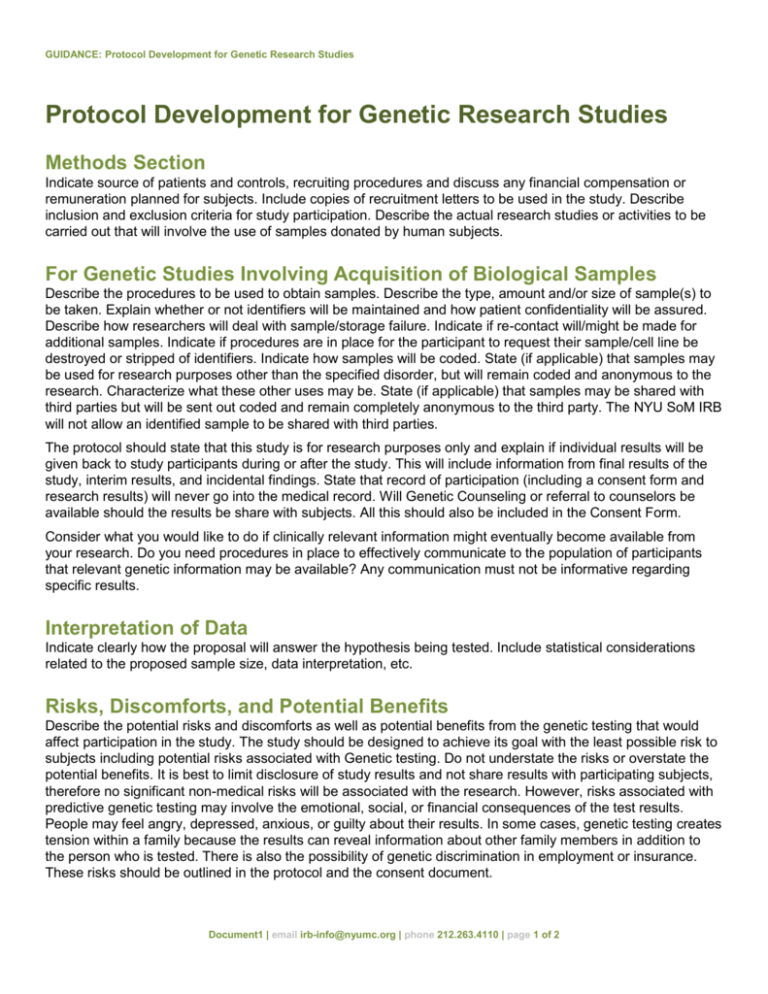
GUIDANCE: Protocol Development for Genetic Research Studies Protocol Development for Genetic Research Studies Methods Section Indicate source of patients and controls, recruiting procedures and discuss any financial compensation or remuneration planned for subjects. Include copies of recruitment letters to be used in the study. Describe inclusion and exclusion criteria for study participation. Describe the actual research studies or activities to be carried out that will involve the use of samples donated by human subjects. For Genetic Studies Involving Acquisition of Biological Samples Describe the procedures to be used to obtain samples. Describe the type, amount and/or size of sample(s) to be taken. Explain whether or not identifiers will be maintained and how patient confidentiality will be assured. Describe how researchers will deal with sample/storage failure. Indicate if re-contact will/might be made for additional samples. Indicate if procedures are in place for the participant to request their sample/cell line be destroyed or stripped of identifiers. Indicate how samples will be coded. State (if applicable) that samples may be used for research purposes other than the specified disorder, but will remain coded and anonymous to the research. Characterize what these other uses may be. State (if applicable) that samples may be shared with third parties but will be sent out coded and remain completely anonymous to the third party. The NYU SoM IRB will not allow an identified sample to be shared with third parties. The protocol should state that this study is for research purposes only and explain if individual results will be given back to study participants during or after the study. This will include information from final results of the study, interim results, and incidental findings. State that record of participation (including a consent form and research results) will never go into the medical record. Will Genetic Counseling or referral to counselors be available should the results be share with subjects. All this should also be included in the Consent Form. Consider what you would like to do if clinically relevant information might eventually become available from your research. Do you need procedures in place to effectively communicate to the population of participants that relevant genetic information may be available? Any communication must not be informative regarding specific results. Interpretation of Data Indicate clearly how the proposal will answer the hypothesis being tested. Include statistical considerations related to the proposed sample size, data interpretation, etc. Risks, Discomforts, and Potential Benefits Describe the potential risks and discomforts as well as potential benefits from the genetic testing that would affect participation in the study. The study should be designed to achieve its goal with the least possible risk to subjects including potential risks associated with Genetic testing. Do not understate the risks or overstate the potential benefits. It is best to limit disclosure of study results and not share results with participating subjects, therefore no significant non-medical risks will be associated with the research. However, risks associated with predictive genetic testing may involve the emotional, social, or financial consequences of the test results. People may feel angry, depressed, anxious, or guilty about their results. In some cases, genetic testing creates tension within a family because the results can reveal information about other family members in addition to the person who is tested. There is also the possibility of genetic discrimination in employment or insurance. These risks should be outlined in the protocol and the consent document. Document1 | email irb-info@nyumc.org | phone 212.263.4110 | page 1 of 2 GUIDANCE: Protocol Development for Genetic Research Studies Confidentiality Mention the ways in which the rights and welfare of the subjects will be protected. State that confidentiality will be preserved to the fullest extent by the research team, however that this cannot be guaranteed. State that research study participation information including research results will not be given to family members, insurance companies, employers or other third parties without written permission of the subject and IRB approval. Any shared samples must be anonymized to the recipient. If samples are to be collected using "mailers", describe the procedures in place to avoid unintentional disclosure as can occur if an insurance company is billed for the phlebotomy. Informed Consent and Documentation of Informed Consent Describe the manner in which informed consent will be obtained from subjects who will participate in the proposed studies or activities. Provide a copy of your written informed consent document for IRB approval. Include in both your protocol submission and informed consent document the following elements: State that informed consent is for genetic research purposes and will not appear in the medical record. State that specific information resulting from genetic research will not be available to participants and their families. Include information about the DNA sample to be taken, including whether or not cell lines will be established. Detail how the cell line/DNA sample will be used. Consider offering the participant the option of allowing samples to be shared or not. Explain if samples will be shared with other investigators (third parties). Indicate that shared samples will be anonymous to the other investigators. Consider offering the participant the option of allowing samples to be shared or not. Indicate if samples will be used for secondary uses. In other words, research other than for what it was collected. Secondary uses may only be done on anonymized or anonymous samples. If you have a Newsletter or other means to communicate general information regarding research results (e.g., new gene mutation discovered in X disorder), offer participants the option of receiving general information. If the Genetic Testing is an optional part of the study indicate this and include and opt in/out section where subjects can check a box and initial. Two copies of the informed consent should exist. An original copy should be filed in the research files and a second copy for the participant. Document1 | email irb-info@nyumc.org | phone 212.263.4110 | page 2 of 2








